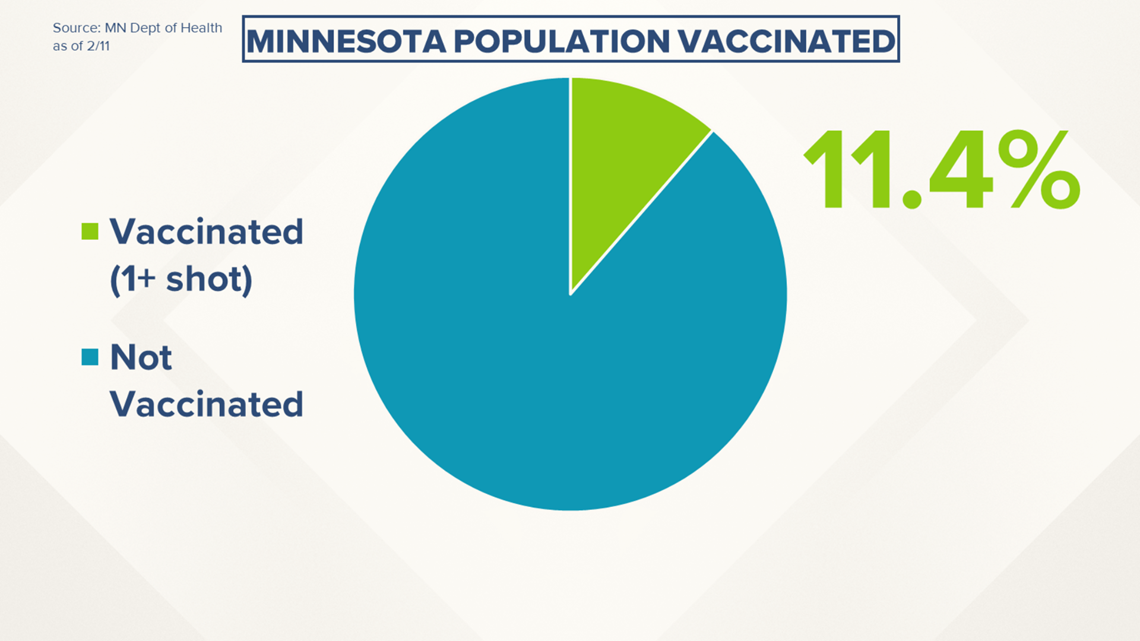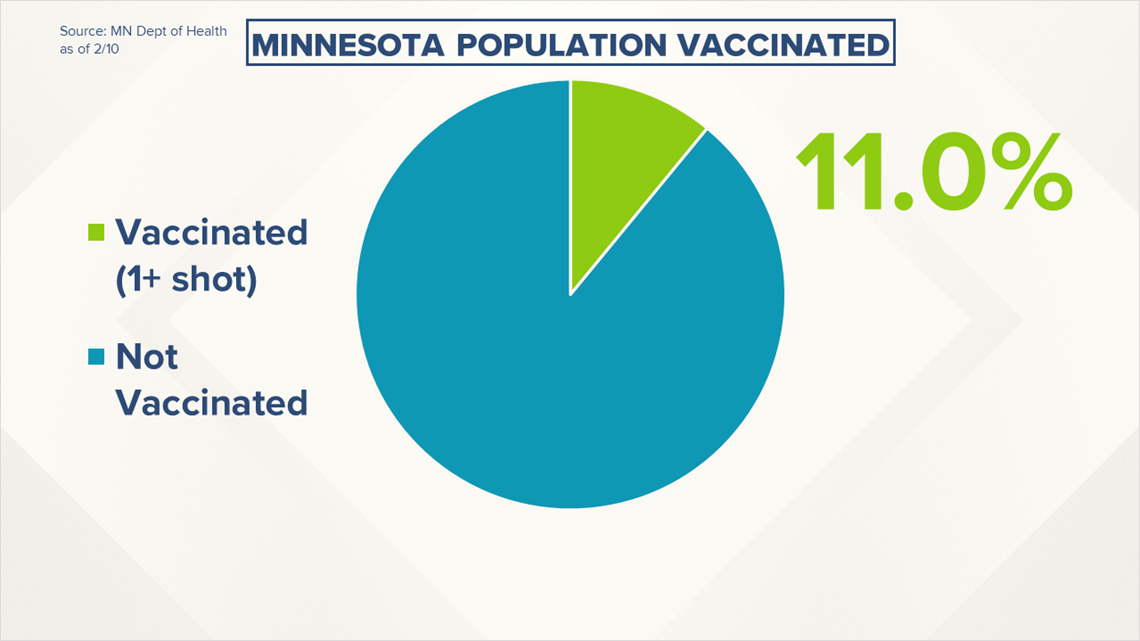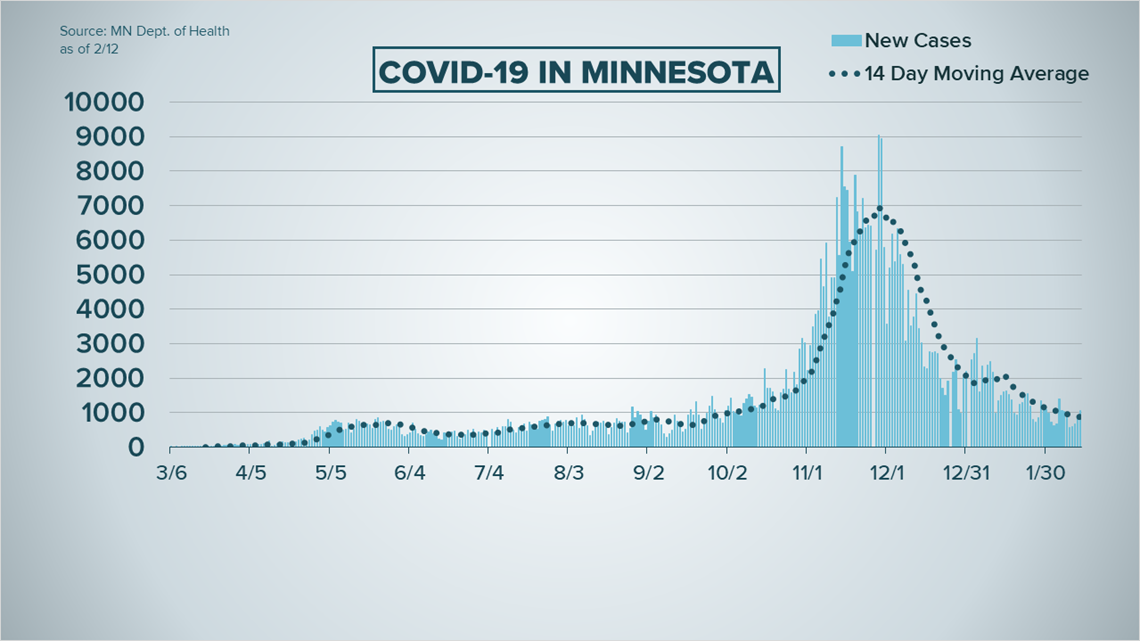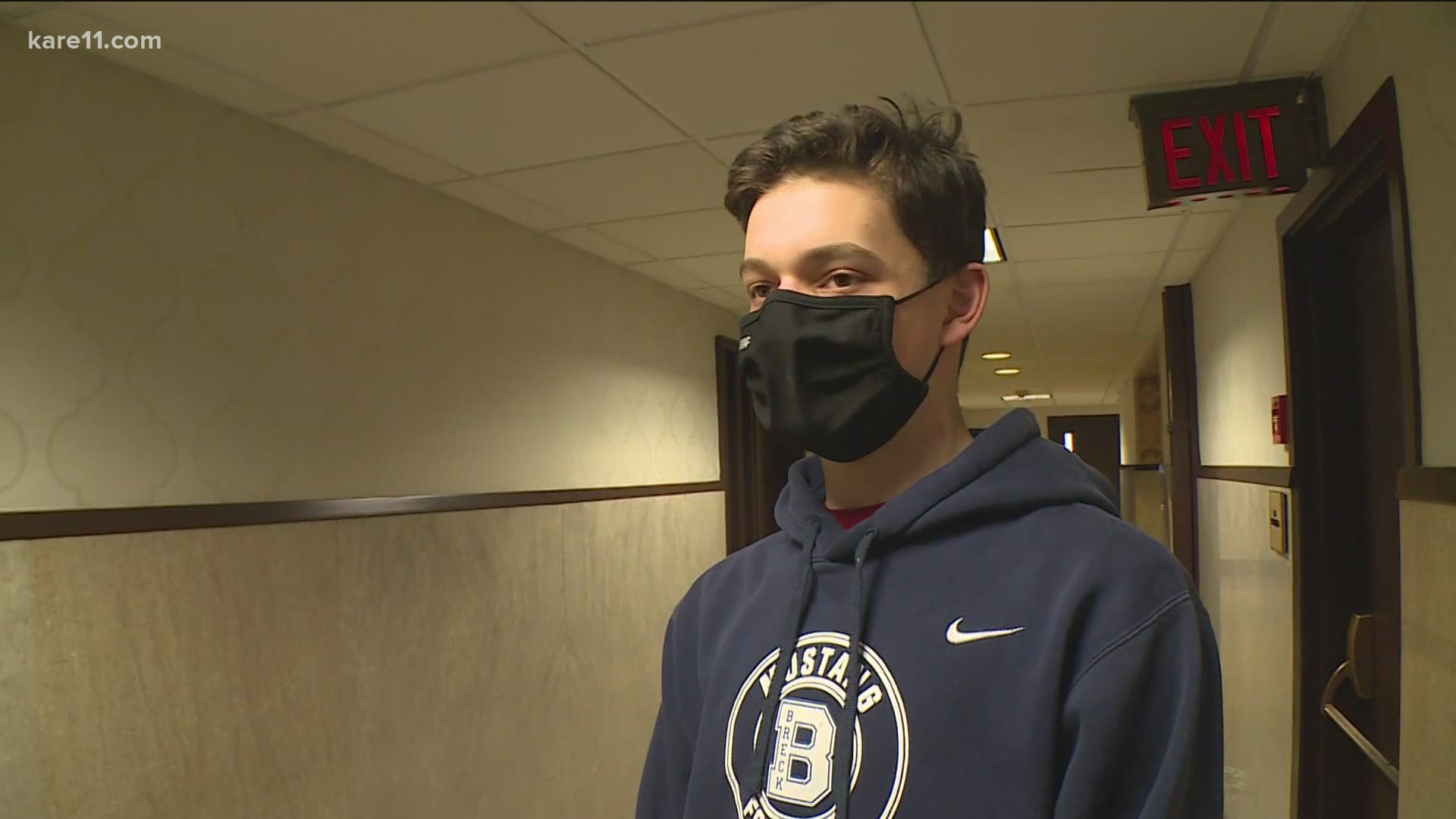ST PAUL, Minn — Sunday, Feb. 14
- MDH: More than 200,000 in Minnesota have received both COVID-19 vaccine doses; more than 650,000 have received at least one
- Walz extends COVID-19 peacetime emergency another 30 days
- Walz expands capacity limits in restaurants, entertainment spaces, gyms, pools and private events, and allows restaurants and bars to remain open until 11 p.m.
- CDC to announce school reopening guidance at 1 p.m.
- Fauci says all Americans should be eligible for COVID vaccines by April
- CDC: Fully vaccinated people don't need to quarantine after exposure
- MDH: Nearly 30% of Minnesotans 65+ have gotten at least one dose
- Delta offering rapid COVID testing at Minneapolis-St. Paul International Airport
- Wisconsin health officials report 503 new cases, one death
2 p.m.
Wisconsin's Department of Health Services (WDHS) reported 503 new cases Sunday, bringing the total number of cases since the pandemic began to 555,303.
Health officials reported one new death on Sunday as the total number of fatalities rose to 6,162, approximately 1.1% of those who are infected with the virus.
On Thursday, Feb. 4, Wisconsin's Republican-controlled Legislature repealed Democratic Gov. Tony Evers' statewide mask mandate. Shortly after, Gov. Evers reinstated the mask mandate order.
Wisconsin health officials say a total of 25,302 people have been hospitalized from the coronavirus since the start of the pandemic, about 4.6% of the total number of people who have been diagnosed with the virus.
Of the confirmed cases in Wisconsin, 18.8% involve people between the ages of 20 to 29, 15.6% are between 30 and 39, 15.2% are between 50 and 59, and 14.2% are 40 to 49. An estimated 11.5% are between 10 and 19, and 10.9% are between 60 and 69.
As of Saturday, Milwaukee County reported the largest number of confirmed cases with 97,006, along with 1,188 deaths. Waukesha County has reported 39,993 confirmed cases and 466 deaths, Dane County has reported 39,270 confirmed cases and 264 deaths, and Brown County has reported 29,888 cases and 202 deaths.
11 a.m.
New COVID-19 cases dipped Sunday, with new deaths remaining in the single digits for the second day in a row.
The Minnesota Department of Health (MDH) reported 779 new cases, along with seven new deaths. The new case total includes 642 confirmed cases and 137 probable cases.
As for the state's vaccination effort, MDH reports that 661,187 people in the state have received at least one dose of the COVID-19 vaccine, and 227,551 of them have received both doses. As MDH has a several-day delay in releasing vaccination data, those numbers were reported as of Friday.
The total number of Minnesotans who have tested positive for the virus since the pandemic began is now 473,567, with 21,806 of those as antigen test results.
MDH says seven new deaths from the virus were reported. That pushes the total number of fatalities in Minnesota to 6,376.
To date, 25,156 Minnesotans have been hospitalized with the coronavirus since the pandemic started, with 5,190 of them needing care in the ICU.
MDH reports that 459,525 people once diagnosed with the virus have passed the point where they are required to isolate.
Of those who have tested positive, people between the ages of 20-24 account for the most cases with 47,369 cases and three deaths, and ages 25-29 follow with 42,448 cases and six deaths. Those between 85 and 89 years old account for the highest number of fatalities in one age group with 1,208 out of 6,169 diagnosed cases.
In terms of likely exposure to the coronavirus, MDH says 104,692 cases were the result of community transmission with no known contact with an infected person, and 96,981 had known contact with a person who has a confirmed case.
A total of 38,801 cases involved exposure in a congregate living setting,
7,908 were in a corrections setting, and 1,002 were in a homeless shelter. MDH data shows 18,510 were linked to an outbreak outside of congregate living or health care.
MDH says 32,377 cases were linked to travel. Health care workers or patients account for 14,549 diagnosed COVID-19 cases. The source of transmission for 158,747 cases is still unknown or missing.
MDH has prioritized testing for people in congregate care, hospitalized patients and health care workers, which may impact the scale of those numbers. However, now MDH is urging anyone who is symptomatic or even asymptomatic to be tested. Testing locations can be found online.
Hennepin County has had the most COVID activity in the state with 98,278 cases and 1,569 deaths, followed by Ramsey County with 42,164 cases and 787 deaths, Dakota County with 35,121 cases and 377 deaths, and Anoka County with 32,557 cases and 379 deaths.
Full data, including a breakdown of PCR and antigen test totals in some categories, can be found on MDH's website.
The Minnesota Department of Health has said repeatedly that the number of lab-confirmed cases is only the "tip of the iceberg" when it comes to the true number of COVID-19 cases in the state.
The state of Minnesota has set up a data portal at mn.gov/covid19.
Saturday, Feb. 13
2 p.m.
Wisconsin's Department of Health Services (WDHS) reported 752 new cases Saturday, bringing the total number of cases since the pandemic began to 553,110.
Health officials reported 10 new deaths on Saturday as the total number of fatalities rose to 6,161, approximately 1.1% of those who are infected with the virus.
Wisconsin health officials say a total of 25,268 people have been hospitalized from the coronavirus since the start of the pandemic, about 4.6% of the total number of people who have been diagnosed with the virus.
Of the confirmed cases in Wisconsin, 18.8% involve people between the ages of 20 to 29, 15.6% are between 30 and 39, 15.2% are between 50 and 59, and 14.2% are 40 to 49. An estimated 11.5% are between 10 and 19, and 10.9% are between 60 and 69.
As of Saturday, Milwaukee County reported the largest number of confirmed cases with 96,918, along with 1,188 deaths. Waukesha County has reported 39,978 confirmed cases and 466 deaths, Dane County has reported 39,212 confirmed cases and 264 deaths, and Brown County has reported 29,878 cases and 202 deaths.
A more detailed breakdown of cases by county can be found on the DHS website.
11 a.m.
As new COVID-19 cases dip back below 1,000 in Minnesota, the state has passed another vaccine milestone: More than 200,000 people have received both vaccine doses.
The Minnesota Department of Health said 641,844 people in the state have received at least one vaccine dose, while 209,010 have received both doses. As there is a several-day lag between for the state's vaccination data, those numbers are accurate as of Feb. 11.


As for other COVID-19 data, MDH reported 964 new cases and 7 new deaths.
MDH's COVID-19 case definition includes both antigen testing and polymerase chain reaction (PCR) testing. Positive PCR test results are considered confirmed cases, while positive antigen test results are considered probable cases.
Saturday's new case total includes 821 confirmed cases and 143 probable cases.
The total number of Minnesotans who have tested positive for the virus since the pandemic began is now 472,791, with 21,669 of those as antigen test results.
MDH says 7 new deaths from the virus were reported. That pushes the total number of fatalities in Minnesota to 6,369.
To date, 25,116 Minnesotans have been hospitalized with the coronavirus since the pandemic started, with 5,183 of them needing care in the ICU.
MDH reports that 458,492 people once diagnosed with the virus have passed the point where they are required to isolate.
Of those who have tested positive, people between the ages of 20-24 account for the most cases with 47,316 cases and three deaths, and ages 25-29 follow with 42,393 cases and six deaths. Those between 85 and 89 years old account for the highest number of fatalities in one age group with 1,208 out of 6,165 diagnosed cases.
In terms of likely exposure to the coronavirus, MDH says 104,362 cases were the result of community transmission with no known contact with an infected person, and 96,724 had known contact with a person who has a confirmed case.
A total of 38,771 cases involved exposure in a congregate living setting,
7,903 were in a corrections setting, and 1,002 were in a homeless shelter. MDH data shows 18,510 were linked to an outbreak outside of congregate living or health care.
MDH says 32,291 cases were linked to travel. Health care workers or patients account for 14,537 diagnosed COVID-19 cases. The source of transmission for 158,691 cases is still unknown or missing.
MDH has prioritized testing for people in congregate care, hospitalized patients and health care workers, which may impact the scale of those numbers. However, now MDH is urging anyone who is symptomatic or even asymptomatic to be tested. Testing locations can be found online.
Hennepin County has had the most COVID activity in the state with 98,122 cases and 1,565 deaths, followed by Ramsey County with 42,101 cases and 787 deaths, Dakota County with 35,042 cases and 376 deaths, and Anoka County with 32,517 cases and 378 deaths.
Full data, including a breakdown of PCR and antigen test totals in some categories, can be found on MDH's website.
The Minnesota Department of Health has said repeatedly that the number of lab-confirmed cases is only the "tip of the iceberg" when it comes to the true number of COVID-19 cases in the state.
The state of Minnesota has set up a data portal at mn.gov/covid19.
The first case in Minnesota was confirmed on March 6, 2020.
Friday, Feb. 12
4 p.m.
On Friday afternoon, Governor Tim Walz signed an executive order extending the COVID-19 peacetime emergency he put in place last March.
This is its 11th extension, and will last until March 15.
The peacetime emergency gives the governor more authority to make quick decisions and issue executive orders related to the pandemic.
According to a press release from the governor's office, some of its other impacts include:
- Supporting the expansion of Minnesota’s testing capacity
- Protecting Minnesotans against evictions and wage garnishment
- Providing expedited procurement power for personal protective equipment (PPE) and other equipment
- Requiring Minnesotans to wear a face covering in certain settings to prevent the spread of COVID-19
- Providing economic relief and stability to Minnesotans and small businesses impacted by the pandemic.
“We are beginning to see the vaccine’s impact in protecting health care workers, first responders, and the elderly in long-term care settings, but we need to remain cautious as we monitor new COVID-19 variants and work to prevent another surge in cases,” Walz said in the release. “The peacetime emergency gives us the tools (to) protect Minnesotans’ health and wellbeing and deliver the vaccine in a way that is effective, safe, and equitable.”
Walz added that he hopes to work collaboratively with the Minnesota Legislature to "ensure an orderly end" of the peacetime emergency when it is no longer needed.
11 a.m.
Governor Walz announced on Friday that he has signed a new executive order loosening some COVID-19 restrictions due to vaccination progress in the state.
According to the Minnesota Department of Health's (MDH) vaccination dashboard, 617,896 people in Minnesota have received at least one dose as of Wednesday. Of that number, 189,902 people have completed the two-shot COVID series.
Among those who have received one dose, 263,908 people are age 65 or older, and 223,950 are between the ages of 18 to 49 (most of whom are front line workers and first responders),
The MDH data shows about 11% of the state's 5.6 million residents have received one dose or more.


MDH also reported Friday that 1,058 cases of coronavirus were recorded in the past 24-hour reporting period. Those cases are based on results from 43,554 tests (38,965 PCR, 4,589 antigen) processed in private and state labs. Health officials consider a positive PCR test a confirmed COVID case, while a positive antigen test is considered a probable case.
On Friday morning, Governor Tim Walz also highlighted Minnesota's efforts to test educators as part of the state's work to return to in-person learning. This comes ahead of an afternoon announcement on Friday from the Centers for Disease Control regarding guidance for reopening schools.
Minnesota now has 471,851 positive COVID cases since the pandemic arrived in the state. Of those cases, 21,538 were diagnosed by antigen testing.
Another 19 Minnesotans have died from the virus, bringing total fatalities to 6,362. Of that total 4,011, or about 63% are tied to assisted living or long-term care settings.
Minnesota hospitals report that as of Thursday, 253 non-ICU beds are being used to treat COVID-19 patients, along with 73 ICU beds. Total hospitalizations in the state since the pandemic began are up to 25,047, with 5,176 patients needing ICU care.
MDH says 457,359 people who at one time tested positive have recovered enough to no longer require isolation.


Young adults age 20 to 24 account for the state's largest group of cases with 47,246 and three deaths. People between 85 and 89 recorded the most COVID deaths with 1,208 in just 6,155 cases.
Hennepin County reports the most COVID activity in the state with 97,956 cases and 1,565 deaths, followed by Ramsey County with 42,014 cases and 784 deaths, Dakota County with 34,976 cases and 378 deaths, and Anoka County with 32,464 cases and 378 deaths. Cook County in northeastern Minnesota now reports 118 cases since the start of the pandemic, the smallest number in the state.
Thursday, Feb. 11
2 p.m.
The Minnesota Department of Health (MDH) is urging the public to stay vigilant even as the state’s COVID-19 situation has improved to the most “hopeful” place since June.
MDH Commissioner Jan Malcolm said on a regular briefing call with the media Thursday that the seven-day rolling average test positivity rate is at 3.9%, which is below the caution category. This is the lowest test positivity rate MDH has seen since June 27.
“So that is a very hopeful sign,” Malcolm said.
However, Minnesota health officials still announced another 24 deaths Thursday.
Those people ranged in age from their 30s to over 100 years old, Malcolm said. She noted that the person in their 30s had underlying health conditions.
Malcolm says over 777,000 COVID-19 vaccine doses have now been administered to Minnesotans. Nearly 600,000 people have gotten at least one dose, and more than 177,000 people have gotten both doses.
“There are reasons to feel good about the overall direction that we’re headed,” said MDH Infectious Disease Director Kris Ehresmann said. “The light at the end of the tunnel is growing brighter every day.” Ehresmann added, “We can have hope that we’re on our way to ending the pandemic.”
Ehresmann said almost 30% of the 65+ population in Minnesota has had their first dose of a COVID vaccine. According to the MDH vaccine data dashboard, that's just over 251,000 people.
She said Minnesotans should remember that even if they haven’t gotten one yet, the more people who have been vaccinated, the less competition there is.
“If people can recognize that the vaccine will come and they will get that vaccine, I think that will also help to encourage them,” she said.
She said the hospitalization rates, vaccination progress and test positivity rates are all encouraging. “We’re in a better place right now than we have been in for quite some time,” she said. “But until we finally reach that goal of crushing COVID, we all need to keep our guard up.”
Ehresmann said this is especially true because of the new, faster-spreading variants. Minnesota has confirmed 18 cases of the B117 variant originating in the UK, and two cases of the P1 variant from Brazil. The U.S. has also seen nine cases of the South African variant, Ehresmann said. But the UK volume is spreading at a higher rate.
There have been more than 900 cases in total of the UK variant reported in the U.S., Ehresmann said. "There is a concern that this may become the dominant strain across much of the United States by March,” Ehresmann said.
She encouraged Minnesotans to continue to wear a mask, social distance and avoid crowded spaces. Making sure masks fit tightly and double masking are two steps to “maximizing the benefit” of your mask, Ehresmann said.
A nose wire can also help masks fit more tightly and make them more effective, Ehresmann said. The CDC has given guidance on wearing a mask more effectively on its website.
Ehrenmann also said even with the focus on vaccines, testing remains an important tool in beating the pandemic. “Because of the variants circulating we want you to be attentive,” she said. Masking, social distancing, avoiding large crowds and testing are vital, she said.
Anyone regularly interacting with people outside of their household is encouraged to get tested, in addition to anyone with symptoms. “We’re closer than ever to the end of this pandemic,” Ehresmann said. “Every COVID death we can prevent between now and then is a success story.”
Commissioner Malcolm added that vaccine supplies will likely continue to be limited in the coming months. “We really are in a race against time to vaccinate as many people as possible as quickly as possible to bring this pandemic to an end,” she said.
Minnesota’s vaccine distribution strategy is to “meet people where they are” and to reach marginalized communities that have been hit hardest by COVID-19, Malcolm said.
She said that’s why MDH is mobilizing a combination of local public health, hospitals, pharmacies and community vaccination sites.
MDH officials are still urging the public to avoid going on any winter or spring break trips.
“As tempting as it is especially with these temperatures, it’s still really not a great idea to travel if you can hold off on those plans,” Malcolm said. “Just a sheer perspective of the amount of virus circulating in the nation, and these variants and the degree to which they’re already spreading quickly across the country, our advice would still be to avoid discretionary travel at this point.”
Ehresmann added that the more people travel, the more potential there is for mutations and developments of new variants.
When asked when rollout for Phase 1b and 1c will be announced, Malcolm said they “don’t have a timeline” they can immediately share. "We’re awaiting some additional federal guidance,” Malcolm said. “But we’re certainly also looking at our data here in Minnesota and thinking about what would be the most, kind of some logical next steps.”
Ehresmann pointed out that child care workers and adults 65 and older, some of whom are now being vaccinated in Minnesota, were intended to be in those groups.
“In some ways, the expanded groups that we are vaccinating right now do include some of the populations that were originally intended for 1b,” she said. “It’s just important to remember that when we added those populations, we had not yet finished 1a, our health care workers and our adults in long-term care, and we added 1.1 million people.”
Malcolm responded to a comment from Dr. Anthony Fauci saying that April should be "open season" for vaccinations in the U.S. "That would be really, really welcome news if in fact the vaccine supply increased to that degree,” Malcolm said. “We haven’t seen anything like that yet.”
Malcolm said that vaccination efforts in the White Earth Nation have been a great “success story.” MDH data shows 30.2% of that population has received vaccine, Ehresmann said.
“We are really grateful for the leadership that our tribes have shown in this vaccination effort,” Malcolm said.
11:45 a.m.
Delta announced Thursday that they will resume service from MSP Airport to Amsterdam and will open a rapid testing site for travelers. The rapid testing site will be located in the G Concourse, where Delta's flight to Amsterdam departs.
According to Delta, the Dutch government has required travelers test negative for COVID-19 using a rapid antigen or molecular test within 4 hours of their departing flight. A negative PCR or LAMP test is also required within 72 hours of arriving in the Netherlands.
11 a.m.
New COVID-19 cases in Minnesota neared 1,000 again on Thursday.
The Minnesota Department of Health (MDH) reported 907 new cases of the virus, along with 24 deaths. The new cases are made up of 795 identified by PCR test, considered confirmed; and 112 from antigen tests, considered probable.
The new cases reported Thursday were the highest since last Friday, but cases have remained mostly under 1,000 per day since late January, with a couple of exceptions.
Hospitalizations due to the virus remain steady, with 78 ICU beds taken up across the state, and 242 non-ICU beds. ICU bed availability in the metro stands at 9.3%, with non-ICU bed availability much lower, at 3.9%. That data is as of Wednesday, due to a lag in reporting times.
Currently the state is nearing 600,000 people with at least one dose of a COVID vaccine, and more than 177,000 people have received the full vaccine series. There is a lag with those reported numbers as well, with the most recent data coming from Tuesday.
That means the total number of doses administered have passed 777,000.
MDH is expected to hold one of its regular media briefing calls at 2 p.m. Thursday.
In addition to the vaccine finder tool that MDH has set up, NBC News has launched planyourvaccine.com, which provides a potential timeline even for people who are not eligible yet.

